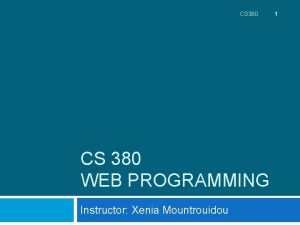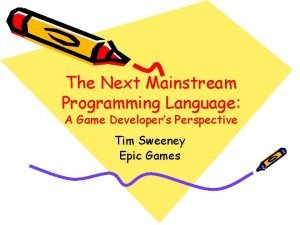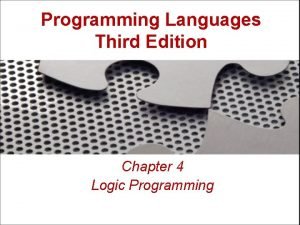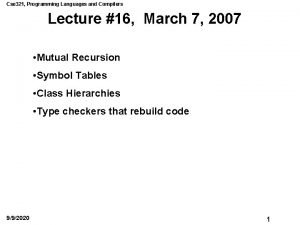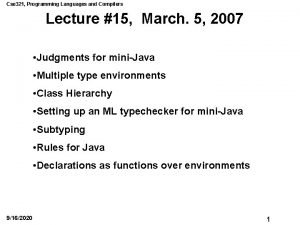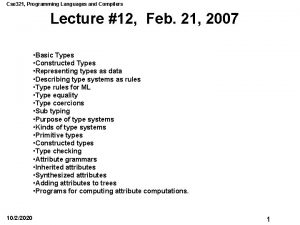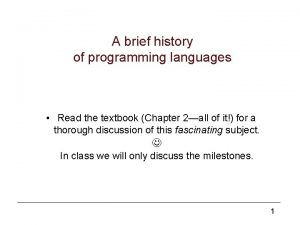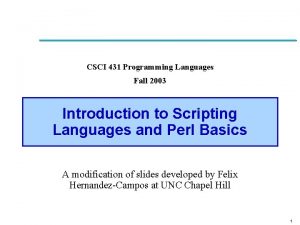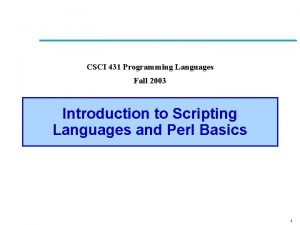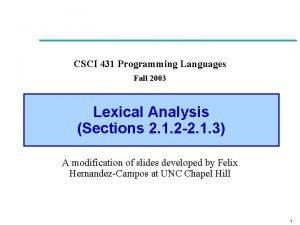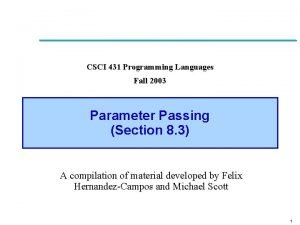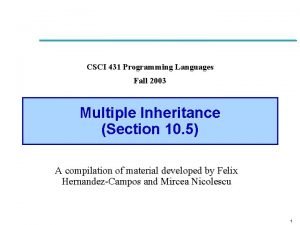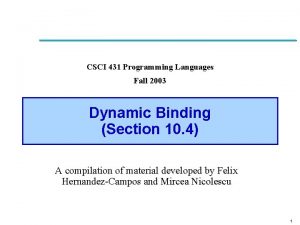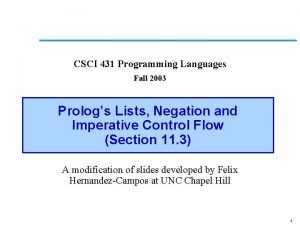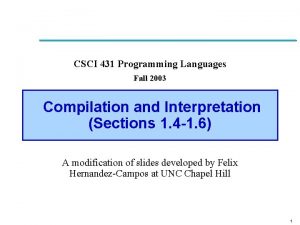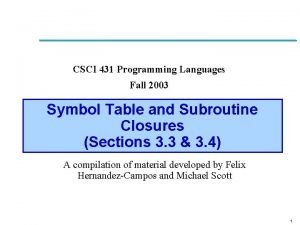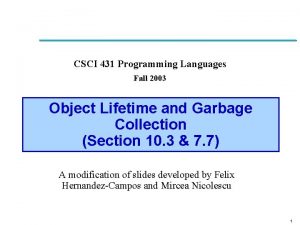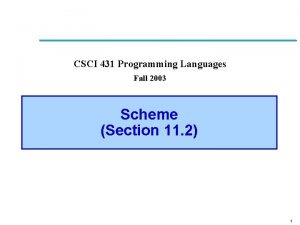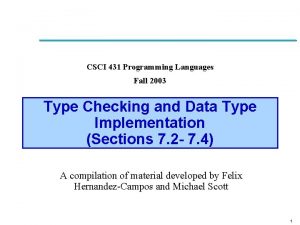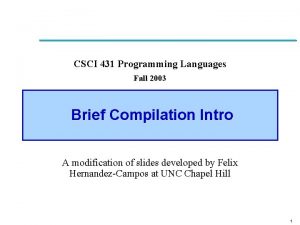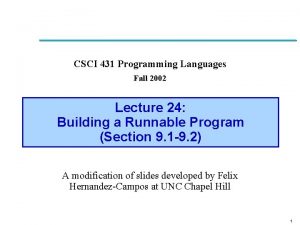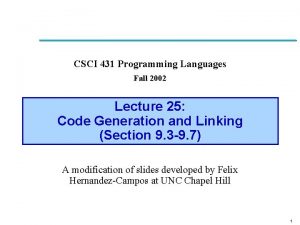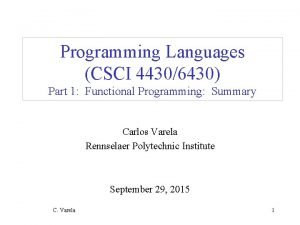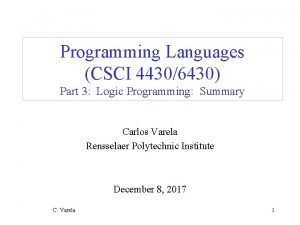CSCI 431 Programming Languages Fall 2003 Introduction to























- Slides: 23

CSCI 431 Programming Languages Fall 2003 Introduction to Logic Programming with Prolog (Section 11. 3) A modification of slides developed by Felix Hernandez-Campos at UNC Chapel Hill 1

Prolog • Prolog is a declarative language • A program is a collection of axioms from which theorems can be proven. – Rather than describing how to compute a solution, a program consists of a data base of facts and logical relationships (rules). – Rather then running a program to obtain a solution, the user asks a question. When asked a question, the run time system searches through the data base of facts and rules to determine (by logical deduction) the answer. 2

Logic Programming • Axiom are written in a standard form known as Horn clauses – A Horn clause consists of a consequent (head H) and a body (terms Bi) H B 1, B 2, …, Bn – Semantics: when all Bi are true, we can deduce that H is true 3

Resolution • Horn clauses can capture most logical statements – But not all • The derivation of new statements is known as resolution – The logic programming system combines existing statements to find new statements – For instance, C A, B A and B imply C D A, B If we know that A and B imply C, and that C implies D, then we can deduce that A and B imply D 4

Example Variable flowery(X) rainy(X) Predicate Applied to a Variable rainy(Rochester) Predicate Applied to an Atom flowery(Rochester) Free Variable X acquired value Rochester during the resolution This is known as Unification 5

Prolog • PROgramming in LOGic • It is the most widely used logic programming language • Its development started in 1970 and it was result of the collaboration between researchers from Marseille, France, and Edinburgh, Scotland • Main applications: – Artificial intelligence: expert systems, natural language processing, … – Databases: query languages, data mining, … – Mathematics: theorem proving, symbolic packages, … 6

A Prolog Program • The program, sometimes called Database is a text file (*. pl) that contain the facts and rules. It contains all the relations needed to define the problem. • When you launch a program you are in query mode represented by the ? – prompt. In query mode you ask questions about the relations described in the program. • When Prolog is launched the ? - should appear meaning you are in query mode. In SWI-Prolog you can load a program by typing the command [file]. when the file containing your program is file. pl. When you have done this you can use all the facts and rules that are contained in the program. 7

SWI-Prolog • We will use SWI-Prolog for the Prolog programming assignment – http: //www. swi-prolog. org/ • After the installation, try the example program ? - [likes]. % likes compiled 0. 00 Yes ? - likes(sam, curry). No ? - likes(sam, X). X = dahl ; X = tandoori ; X = kurma ; Load example likes. pl sec, 2, 148 bytes This goal cannot be proved, so it assumed to be false (This is the so called Close World Assumption) Asks the interpreter to find more solutions 8

Example Program location(desk, office). Query location(apple, kitchen). location(flashlight, desk). location('washing machine', cellar). ? - location(apple, kitchen). yes location(nani, 'washing machine'). location(broccoli, kitchen). location(crackers, kitchen). location(computer, office). 9

Prolog Programming Model • A program is a database of (Horn) clauses that are assumed to be true. • The clauses in a Prolog database are either facts or rules. Each ends with a period. • A fact is a clause without a right-hand side. – rainy(asheville). • A rule has a right-hand side. – snowy(X) : - rainy(X), cold(X). • The token : - is the implication symbol. • The comma (, ) indicates “and” 10

Prolog Clauses • A query or goal is a clause with an empty left-hand side. Queries are given to the prolog interpreter to initiate execution of a program. • Each clauses is composed of terms: – Constants (atoms, that are identifier starting with a lowercase letter, numbers, punctuation, and quoted strings) » E. g. curry, 4. 5, +, ‘Hi, Mom’ – Variables (identifiers starting with an uppercase letter) » E. g. Food – Structures (predicates or data structures) » E. g. indian(Food), date(Year, Month, Day) 11

Structures • Structures consist of an atom called the functor and a list of arguments – E. g. date(Year, Month, Day) – E. g. Functors T = tree(3, tree(2, nil), tree(5, nil)) 3 2 5 12

Principle of Resolution • Prolog execution is based on the principle of resolution – If C 1 and C 2 are Horn clauses and the head of C 1 matches one of the terms in the body of C 2, then we can replace the term in C 2 with the body of C 1 • For example, C 1: likes(sam, Food) : - indian(Food), mild(Food). C 2: indian(dahl). C 3: mild(dahl). – We can replace the first and the second terms in C 1 by C 2 and C 3 using the principle of resolution (after instantiating variable Food to dahl) – Therefore, likes(sam, dahl) can be proved 13

Another Example takes(jane_doe, his 201). takes(jane_doe, cs 245). takes(ajit_chandra, art 302). takes(ajit_chandra, cs 254). classmates(X, Y) : - takes(X, Z), takes(Y, Z). via resolution, yields the new rule: classmates(jane_doe, Y) : - takes(Y, cs 254). 14

Unification • Prolog associates variables and values using a process known as unification – Variable that receive a value are said to be instantiated • Unification rules – A constant unifies only with itself – Two structures unify if and only if they have the same functor and the same number of arguments, and the corresponding arguments unify recursively – A variable unifies to with anything 15

Equality • Equality is defined as unifiability – An equality goal is using an infix predicate = • For instance, ? - dahl = dahl. Yes ? - dahl = curry. No ? - likes(Person, dahl) = likes(sam, Food). Person = sam Food = dahl ; No ? - likes(Person, curry) = likes(sam, Food). Person = sam Food = curry ; No 16

Equality • What is the results of ? - likes(Person, Food) = likes(sam, Food). Person = sam Food = _G 158 ; No Internal Representation for an uninstantiated variable Any instantiation proves the equality 17

Execution Order • Prolog searches for a resolution sequence that satisfies the goal • In order to satisfy the logical predicate, we can imagine two search strategies: – Forward chaining, derived the goal from the axioms – Backward chaining, start with the goal and attempt to resolve them working backwards • Backward chaining is usually more efficient, so it is the mechanism underlying the execution of Prolog programs – Forward chaining is more efficient when the number of facts is small and the number of rules is very large 18

Backward Chaining in Prolog • Backward chaining follows a classic depth -first backtracking algorithm • Example – Goal: Snowy(C) 19

Depth-first backtracking • The search for a resolution is ordered and depth-first – The behavior of the interpreter is predictable • Ordering is fundamental in recursion – Recursion is again the basic computational technique, as it was in functional languages – Inappropriate ordering of the terms may result in nonterminating resolutions (infinite regression) – For example: Graph edge(a, b). edge(b, c). edge(c, d). edge(d, e). edge(b, e). edge(d, f). path(X, X). path(X, Y) : - edge(Z, Y), path(X, Z). Correct 20

Depth-first backtracking • The search for a resolution is ordered and depth-first – The behavior of the interpreter is predictable • Ordering is fundamental in recursion – Recursion is again the basic computational technique, as it was in functional languages – Inappropriate ordering of the terms may result in nonterminating resolutions (infinite regression) – For example: Graph edge(a, b). edge(b, c). edge(c, d). edge(d, e). edge(b, e). edge(d, f). path(X, Y) : - path(X, Z), edge(Z, Y). path(X, X). Incorrect 21

Infinite Regression Goal 22

Examples • Genealogy – http: //ktiml. mff. cuni. cz/~bartak/prolog/genealogy. html • Data structures and arithmetic – Prolog has an arithmetic functor is that unifies arithmetic values » E. g. is (X, 1+2), X is 1+2 – Dates example » http: //ktiml. mff. cuni. cz/~bartak/prolog/basic_struct. html 23
 Introduction to programming languages
Introduction to programming languages Spring, summer, fall, winter... and spring cast
Spring, summer, fall, winter... and spring cast Real-time systems and programming languages
Real-time systems and programming languages Cs 421 programming languages and compilers
Cs 421 programming languages and compilers Multithreaded programming languages
Multithreaded programming languages Cxc it
Cxc it Plc coding language
Plc coding language Joey paquet
Joey paquet Imperative programming languages
Imperative programming languages Alternative programming languages
Alternative programming languages Types of programming languages
Types of programming languages Transmission programming languages
Transmission programming languages Cse 340 principles of programming languages
Cse 340 principles of programming languages Integral data type in c
Integral data type in c Xenia programming languages
Xenia programming languages Advantages and disadvantages of system software
Advantages and disadvantages of system software Mainstream programming languages
Mainstream programming languages Cse 340 principles of programming languages
Cse 340 principles of programming languages Programming languages
Programming languages Programming languages
Programming languages Programming languages
Programming languages Programming languages
Programming languages Language
Language Brief history of programming languages
Brief history of programming languages














